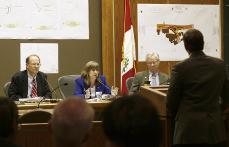City council members approved, in a 5-2 vote, the plans to revitalize Hillsborough Street in a meeting Tuesday night.
Included in these improvements are: two roundabouts located at the intersections of Hillsborough Street and Pullen Road, and Oberlin and Pullen Road; aesthetic improvements to the streetscape; enhanced safety measures for pedestrians and cyclists and relocating sewer and electricity facilities underground.
However, though the council approved the design, it did not approve the project’s funding. According to Ana Pardo, a 2005 alumna and first vice chair of the Hillsborough Street Citizens’ Ad Council, the budget must be sent to and approved by another board.
And according to Josh Weeks, director of government relations, the plan’s final approval is contingent upon finding funding for the project.
“They gave the go-ahead for the plan,” Weeks said. “Now the question is where the money will come from. The first half of the puzzle has been solved.”
The design has been a public issue since its inception.
And since 2005, when George Chapman, chair of the Hillsborough Street Partnership, first suggested the council involve the community in deliberations involving the proposed renovations, he said the community has participated in the process.
“I’ve since wondered if I’ve had great wisdom in asking for that or not,” Chapman said.
However, Chapman said he was satisfied with the design’s progress since its 2002 blueprints, considering the approved plans “superior to beginning thoughts” involving Hillsborough Street’s renovations.
“It’s a practical way to solving problems on Hillsborough Street,” he said. “The board feels generally positive about this redevelopment.”
But John Wardlaw, a life insurance specialist whose building would be affected by the Oberlin Road roundabout, voiced his concerns about the plan to the council.
The 50 feet that separate his property from the curb — the first window 60 feet from the curb — have proved, he said, to be a substantial buffer from the noise emanating from Hillsborough Street. With the approved roundabout, his property will begin 28 feet from the curb — a distance he deemed “too close.”
“What will my address be?” Wardlaw said. “Roundabout 1, Raleigh? What will the front of my building look like?”
With the approved design, Wardlaw will not only lose part of the land his family has owned for 20 years, but the Oberlin roundabout will seize two parking places at the front of his building.
“What guarantees do I have?” Wardlaw said. “I’m [worried about] the excessive damage that might accrue from damages to my parking.”
And though Wardlaw said he agreed with the design’s focus on pedestrian safety, he said that implementing and enforcing a 25-miles per hour speed limit would accomplish the same goal.
And though Chapman said the new design will generate 109 new full-time, 24-hour parking spots on Hillsborough Street, he said this plan isn’t the conclusion of the parking problems drivers face on Hillsborough Street.
But the City isn’t ignoring the existing problems, many of which, Chapman said, will still remain even when the design is completed. He mentioned parking passports, which he said would be a further step in solving the parking problems.
“This project is the beginning of changes on Hillsborough Street,” Chapman said. “It is not the end of it.”








